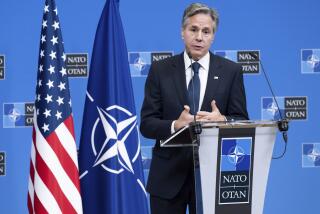Is Japan Ready for a Prime-Time Role as U.S. Defense Partner?
- Share via
WASHINGTON — Tokyo officials, the Japanese public and the rest of Asia are trying to reconcile the Clinton-Hashimoto summit pledge of a more assertive defense role for Japan with its World War II legacy. Even as the Japanese prime minister danced around the details of what a higher military profile would mean for his country, Russian President Boris N. Yeltsin was in Beijing cementing “a new strategic partnership.” The new coziness in Sino-Russian relations is a hint of where mutual fears of expanding alliances could lead.
The familiar homilies on the importance of the U.S.-Japan security treaty, and the U.S. emphasis on keeping 100,000 soldiers in Asia indefinitely, suggest to some observers that the summit’s hoopla was the last gasp of an era past. But the continuing importance of the U.S. “balancing role” in Asia was dramatically conveyed to many Japanese when the aircraft carrier USS Independence recently steamed from its base in Yokusuka into the East China Sea during the Taiwan crisis. It is also possible that Japan’s envisioned defense role signals the beginning of a more equal partnership that could be a cornerstone of security in 21st-century Asia.
But it should be recalled that President George Bush also made, in 1992, a state visit to Japan. Then, the two countries also made impressive pledges to forge a “global partnership” in a document suspiciously similar to Bill Clinton’s and Ryuharo Hashimoto’s “Tokyo declaration.” And not much came of it.
But there may be some critical differences this time around. Hashimoto’s pledge of a more active defense role reflects an erosion of Japan’s anti-military taboos. There are several reasons for this. A new generation in Japan seeks a political status commensurate with its status as the world’s second-largest economy. Over the past decade, Japan’s investment in East Asia has tripled, to about $100 billion. Consequently, it has a more direct stake in regional stability.
Furthermore, as the recent Taiwan Strait crisis underscored, northeast Asia poses increasing strategic risk to Japan. This realization has led to a shift in Japanese attitudes. Fears of a collapse in North Korea and growing concern about China’s emergence as a military and economic power, not to mention burgeoning Russian nationalism, have forced the Japanese public to begin weighing real-time security problems.
Since the Gulf War, when the limits of Tokyo’s cooperation became painfully apparent, Japan has sought to overcome the military-participation rules imposed by its postwar peace constitution. After a tortuous debate, it enacted a less limiting peacekeeping law, sent minesweepers to the Gulf and peacekeepers to Cambodia, Africa and the Golan Heights.
But by agreeing to expand support for U.S. forces in peacetime, to intensify contingency planning for crises and to review the vague 1978 guidelines for defense cooperation, Hashimoto appears to be testing his constitution’s elasticity. New guidelines could mean active military support for U.S. forces in a conflict in Korea or China. At a minimum, this would require reinterpreting the constitution, as critics have already charged.
Yet, reflecting the shift in Japanese sensibilities, many in the Japanese elite--Yomiuri Shimbun (the largest daily), business federations and political leaders--have called for just such a reinterpretion of the U.S.-drafted constitution. Opposition leader Ichiro Ozawa even wants to revise the constitution to accommodate collective security. Post-summit public-opinion polls suggest the anger generated by the Okinawa rape case was muted with the return of 11 facilities to Japan, and that there is strong support for a more active Japanese military role.
But is the Japanese public really ready for prime time? In 1992, when a Japanese peacekeeper was killed in Cambodia, it nearly precipitated a national crisis. Current polls reflect the summit’s afterglow and the scare from the Taiwan crisis. But what happens if there is another incident involving American troops? And would the Japanese public send their boys in harm’s way if there were another Gulf War? The 40-year political culture of pacificism and distrust of the military runs deep in Japan. It has yet to be reconciled with Tokyo’s goal of a permanent U.N. Security Council seat and all that it would imply.
The attitude of the Japanese public is only one factor in determining Tokyo’s defense posture. The response in Asia is another. For China and Korea, in particular, Japan’s brutal behavior during the 1930s and 1940s, and Japan’s inability to face up to this past, continues to fuel deep suspicions of any Japanese regional military role.
All this poses a dilemma for both the United States and Japan. In a region without a formal security system, the U.S. alliance remains key to Washington’s balancing role, and thus to stability in the Pacific. But to sustain the partnership, the American public must be convinced that it is not a one-way street, that there is reciprocity, from open markets to sharing military burdens. The Japanese public, for its part, must participate in a full national debate to better prepare itself for a crisis that would test the limits of the new activism some favor.
The challenge for Tokyo and Washington is how to balance these competing concerns and utilize the collective weight of the world’s two largest economies in shaping not only a security structure in East Asia, but to lead the world in reshaping the international economic and political system to meet the challenges of the 21st century. How successful Japan is in stepping up to such responsibilities will decide whether the Clinton-Hashimoto summit was an important building block for the future or just a holding action of a bygone era.*
More to Read
Sign up for Essential California
The most important California stories and recommendations in your inbox every morning.
You may occasionally receive promotional content from the Los Angeles Times.









